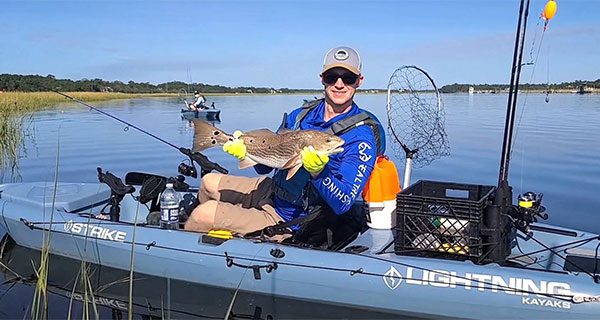I hear the coffee maker ding; I know its 3:30am. As I lay in bed, I mentally clock in and start the day reviewing the prep list from the day before. The kayaks are cleaned and loaded, the reels are rinsed and oiled, and new hooks have been put on new lines. The SUV is packed with kayak crates, pedal drives, life vests, snacks, and drinks, and it’s ready to pull the trailer out from the garage. The electronics are still plugged in and waiting to be loaded at the last minute, along with frozen bait. I have four hours and counting until game time.
The drive is always dark, and it takes longer than it should. Although the fastest route tends to wind through narrow roads littered with potholes, the highway is the safest. Forty minutes later, as I near the boat ramp, the beauty of the Wando River exposes itself, the tree line pulls back, and exposes the tidal saltwater river. I spin the trailer and park off to the side where I begin unload equipment and prep the kayaks. Once finished, I examine the water, its flow, clarity, wind direction, temperature, and local birds hunting overhead as the sun cracks the horizon. I decide on a route for the day based on what I see and feel, not the apps on my phone. Two hours until game time.
The outings start off by greeting the clients and placing names with faces. Unknown to each of them, I have already memorized their names and the cities they are visiting from. The range of experience between clients is diverse, and I make mental notes about who to stay close to. My morning speech is always the same.
“Goal one: Safety! You go home the same way you showed up. There are no ouches, boo-boos, Band-Aids, pregnancies, or divorces allowed during our outing today.” This tends to break the ice; clients chuckle, and smiles brighten.
“Goal two: You will get an educational experience in an amazing environment. You’ll have several hours of my voice teaching you everything I can. This includes everything from our fish to our feathered friends, from the alligators and sharks to the dolphins. In addition, you’ll get to know a bit of Charleston history and the habitat you’re entering”.
“Goal three: We fish, we catch.”
One hour.
As a local guide, I know where the oyster beds lie beneath the surface and where the marsh drops off into large underwater trenches. Years of experience have taught me how to read the landscape, wildlife, and patterns of the local fishery. My eyes constantly scan the area, paying particular attention to the water’s edge along the marsh line around us. The bait fish keep breaking the surface, creating tiny ripples. However, I’m waiting for a sudden push of bait fish through the water, shadows just under the surface, or movement along the reeds. The client rods have a variety of small plastics and baits based on color and local feeding habits during this time of year. The Reds and Speckled Trout hunt year-round here, and it’s just a matter of time before someone lands a cast in front of one. Suddenly, there is an excited yell from a client, “I’m on!” their rod is in a beautiful arch, pointing into the water and the client’s face is filled with excitement. Game time.
